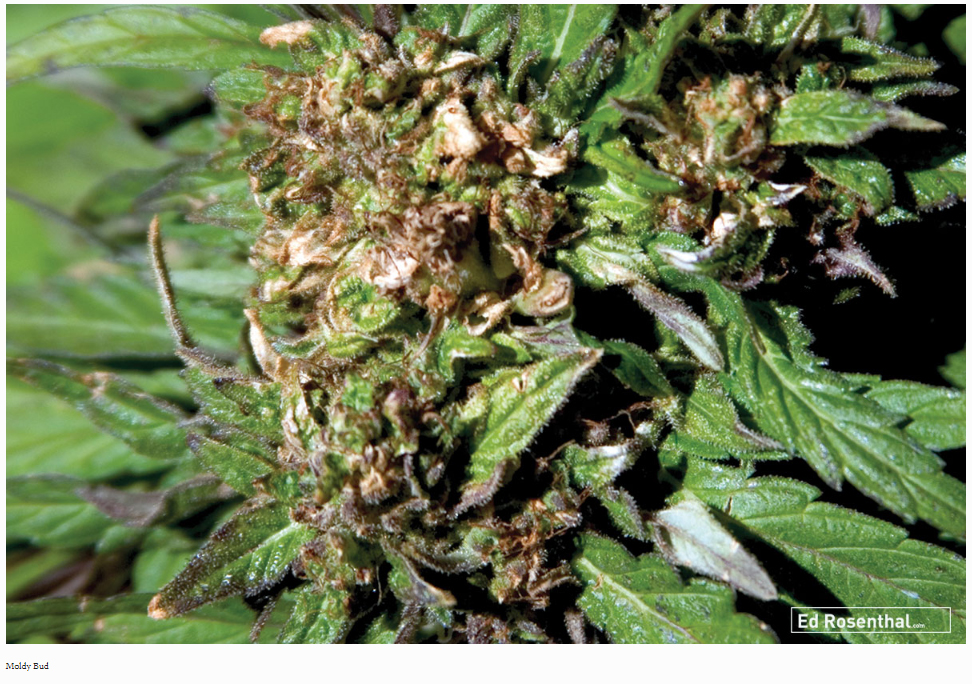July 13, 2018
By Reginald Gaudino V.P. of Science Genetics and Intellectual Property at Steep Hill Labs
Click here to link to the original article at Ed Rosenthal.com

Molds, Bacteria And Yeast Are Present Everywhere, Including In The Air We Breathe
Unless cannabis is grown in a clean room with appropriate air filtration and other good growing and laboratory practices, it is inevitable that these microorganisms will be found on cannabis flowers and products made with them. Most microorganisms do not present a problem at low levels, though some pathogenic microorganisms are harmful even at low levels because they produce toxins that cause a variety of symptoms: from allergy-like symptoms to various types of cancer.
Other microorganisms are harmful at mid to higher levels of contamination, particularly if they are inhaled. Immunocompromised patients including those receiving chemotherapy are at a higher level of risk to all microorganisms, where even low levels of microbial contamination can lead to fatality. Contaminated medical cannabis and incidence of diseases such as Aspergillus nodulosis (a disease caused by the inhalation of Aspergillus niger) has already been noted (1).
Recent Test Shows Randomly Selected Samples All Had Detectable Levels Of Microbial Contamination

Recently, Steep Hill Labs collaborated with medical researchers at University of California, Davis - Medical Center, and found that of 20 randomly selected samples submitted for testing at the Steep Hill Facility in Berkeley, California all had detectable levels of microbial contamination, and many had significant pathogenic microorganism contamination (2). The variety of potentially harmful bacteria and fungi found was surprising and included:
-
Klebsiella, Pseudomonads (several, including P. aeroginosa)
-
Enterobacteria (including both pathogenic and non-pathogenic forms of E. coli)
-
Acinetobacter (several, including baumannii)
-
Aspergillus (in-cluding niger)
-
Fusarium
-
Mucor
-
Penicillium
-
Botryotini
-
And many other bacteria and fungi
-
Some of the samples studied harbored multiple potentially pathogenic microorganisms (e.g., Aspergillus, Fusarium, Penicillium, Enterobacter, Pseudomonas)
Sterilization Of The Product Does Not Necessarily Ensure The Product Is Completely Safe For Consumption

Because the presence of microbial contaminants often results in the by-products of growth being left behind, sterilization of the product does not necessarily ensure the product is completely safe for consumption. Sterilization of the contaminated substance may kill live microbes, but it does not remove the presence of the microbes (DNA, proteins, and/or lip-ids left behind), or remove the toxins certain microbes leave behind. The DNA, lipids and proteins from microbial contaminants, whether pathogenic or nonpathogenic, also have the potential of acting as antigenic determinants on their own, and could lead to a full range of allergy like reactions. If the cannabis contaminated with pesticides, mycotoxins or endotoxins is destined for extraction and concentration, there is a significant risk that the contaminants, particularly pesticides will be concentrated and become a greater problem for the end user.
Pharmaceutical Grade Medical Cannabis Can Be Produced Using Good Growing Practices (GGP)

This requires clean grow rooms/green houses, complete humidity and ventilation control, HEPA filtered air systems and gowned workers wearing hair covering; essentially the same practices used to produce pharmaceutical products. Without this infrastructure, it is impossible to avoid microbial contamination, which leads to pesticide usage.
Pesticides add another level of risk to the cannabis end user. Thresholds targeted in those states that even require pesticide testing are based on information from studies done on skin contact or ingestion. None of the research conducted studied pesticide inhalation. So the levels being considered aren’t relevant to potential harm or risk mediation for the in-tended use. It is likely that many of the pesticides used will have very different effects, and at much lower levels, due to the introduction through the lungs while smoking.
It has already been well publicized that Myclobutanil, the primary ingredient used to control fungal infestations (particularly powdery mildew), turns to Cyanide gas. Further investigation into the effect of all pesticides used on cannabis is needed, as are experiments to identify the types, if any, of microbial contaminants that pass through the smoke stream. Investment in these Standard Operating Procedures will enable the production of more consistent cannabis product between batches, assuming identical or nearly identical genetics are used each growing cycle.

To ensure the safety of any cannabis flower product, but particularly medical Cannabis, grown under any conditions, DNA based microbial testing methods (e.g., PathogenDx, qPCR, DNA microbiome sequencing) must provide the necessary scientific rigor to ensure compliance with pharmaceutical standards.
Detection of DNA indicates that a particular species was resident on the plant at some point, absence indicates the complete lack of colonization of the flower by whichever species. Detection of a species known to produce toxins should require testing for that toxin. Absence of the toxin, and presence of the microbe below levels established for specific patient groups, would allow certification of the product for use by some patients and adult users. If toxin residue or pesticides or serious microbial contamination is detected, that product could be evaluated for remediation (e.g., chemical extraction and fractionation to produce extracts free of the contaminant).
1. Fatal aspergillosis associated with smoking contaminated marijuana, in a marrow transplant recipient: R Hamadeh, et al. Chest. 1988;94(2):432-433. doi:10.1378/chest.94.2.432, Salmonel-losis Associated with Marijuana—A Multistate Outbreak Traced by Plasmid Fingerprinting D.N. Taylor, M.D., et al. N Engl J Med 1982; 306:1249-1253, Aspergillus: An Inhalable Contaminant of Marihuana N Engl J Med 1981; 304:483-484
2. Thompson et al, “A Microbiome Assessment of Medical Marijuana”, Clinical Microbiology and Infection (2017), doi: 10.1016/j.cmi.2016.12.001

